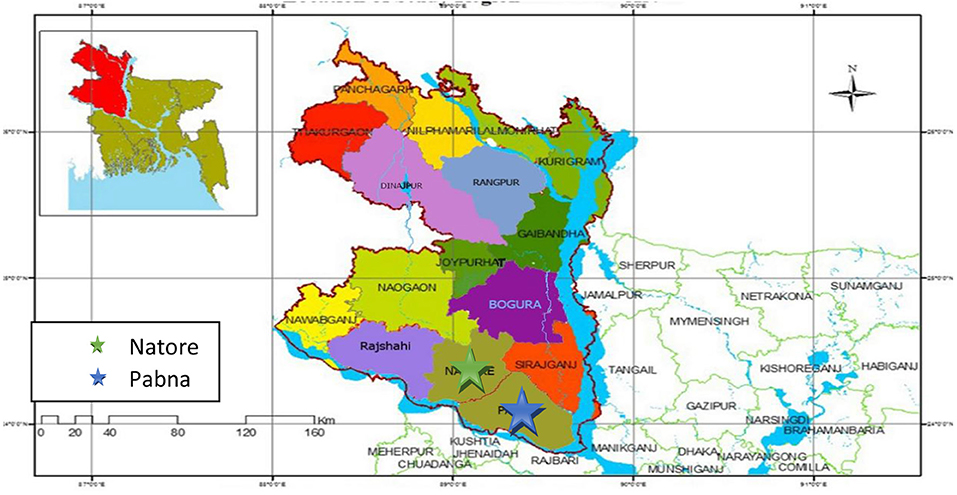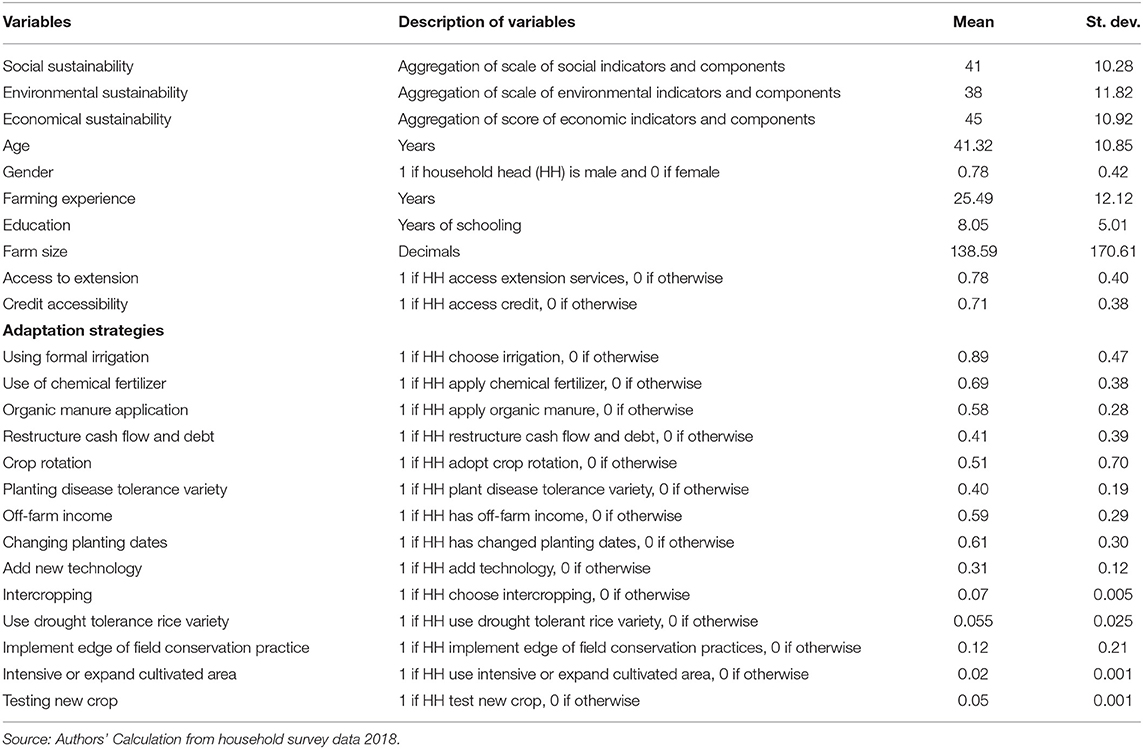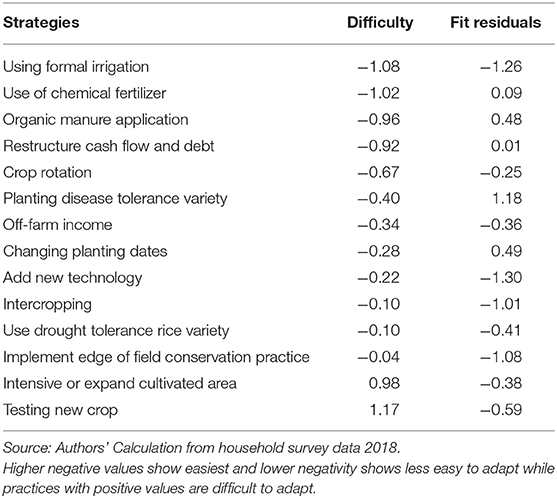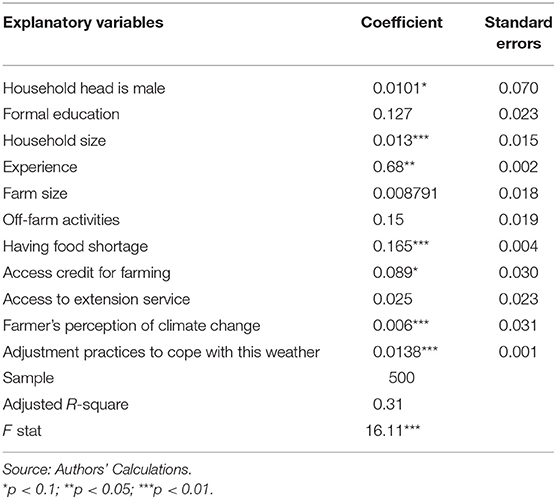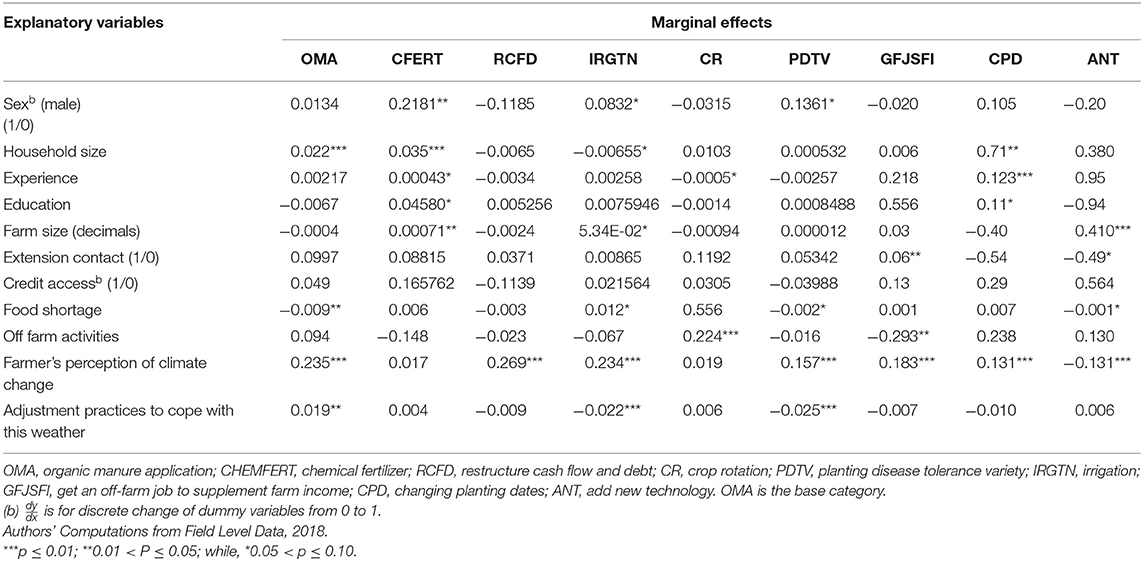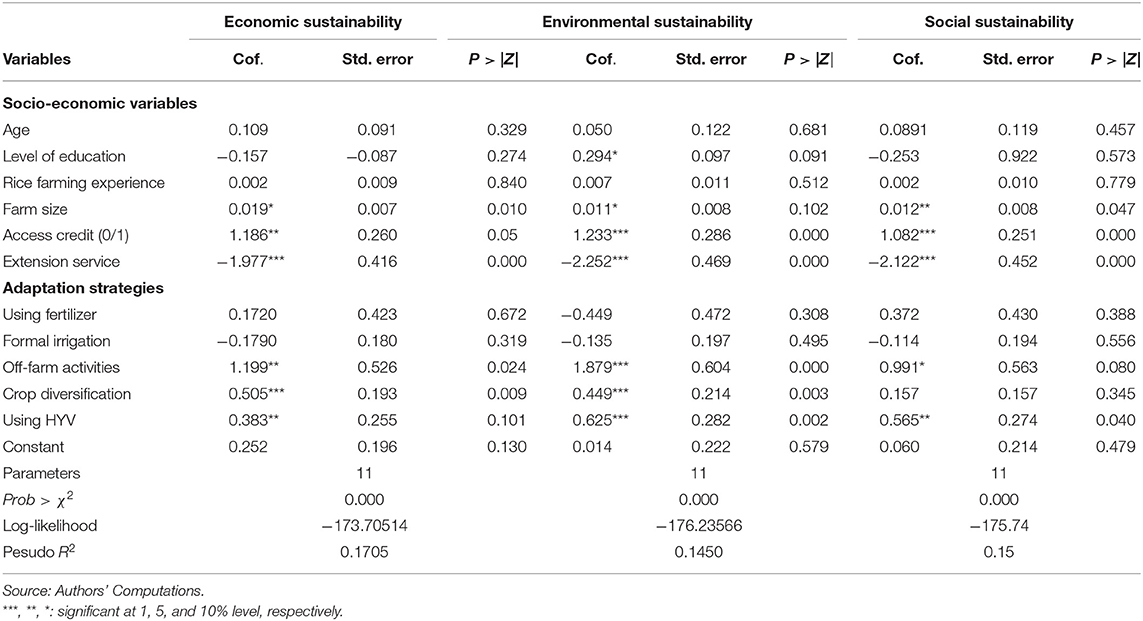- 1Department of Economics, Pabna University of Science and Technology, Pabna, Bangladesh
- 2Department of Economics and Development Studies, Covenant University, Ota, Nigeria
Climate change alters the impact of the environment on economies, and sustainable adaptation which may improve food security is embedded in the actualization of the 2030 United Nations Sustainable Development Goals (SDGs) 2, 13, and 14. Hence, this study contributes to the debate by measuring how farmers in the Northwestern region of Bangladesh adapt to climate change. A cross-sectional multistage random sampling is used to collect 500 data points by the face-to-face interview method. For robustness, the study demonstrates climate change adaptations, adaptation indices, and the sustainability indicators in social, economic, and environmental concepts using the composite indicator method. Also, Rasch analysis and marginal contribution were used to explain the adaptation indices. Finally, a trivariate Tobit regression is used to examine sustainability analyses of climate change adaptation strategies and explain how the climate change adaptations affect different dimensions of sustainability. The results showed that dominant male households, extended family, skilled farmers and food security influenced adaptation index as well as adaptation strategies like organic manure, changing planting dates, diseases tolerant varieties and irrigation. Though, most dominant strategies like irrigation and applying fertilizer are not sustainable. The study also found that farm size, credit access, and extension contact significantly affects sustainability. Moreover, off-farm activities, crop diversification, and using high-yield varieties are more sustainable adaptation strategies. Policy should be implemented on the basis of region and sustainable manner.
Introduction
The agricultural sector is burdened with the responsibility to tackle food security at the national and global levels (Schmidhuber and Tubiello, 2007; Barrett, 2010; FAOSTAT, 2015; Alam, 2016; Pandey et al., 2016; Adeleye et al., 2020; Osabohien et al., 2020). But food sustainability and security are hampered by the incidence of climate change. Though agriculture contributes the least to climate change, its adverse effect is felt due to the increase in the severity of the weather (Herring et al., 2014; Hulme, 2014; Adeleye et al., 2021), which adversely affects climate-related food productivity and accessibility (IPCC, 2001; UNFCCC, 2009; Dodman and Miltan, 2011; Wilson et al., 2014). Given that agricultural integration is crucial for sustainable socio-economic development, when agriculture is adversely affected by climate change it causes a decline in economic growth, worsens poverty levels, and further generates new poverty traps (Gautam, 2008; IPCC, 2014; Alemayehu and Bewket, 2016).
Adapting to climate change requires the need to minimize susceptibility and attendant risks (Barnett, 2010). Given this, several adaptation measures have been implemented in the bid to reduce the harmful effects of climate change (Donner et al., 2016; Dinesh et al., 2017; Weiler et al., 2018). Notably, existing adaptation choices are tied to resource constraints, human cognition, and socio-economic factors but ignore the adverse effects of adaptation policies and sustainable practices (Grothmann and Patt, 2005; UNFCC, 2009; Brown, 2011; Eriksen and Brown, 2011; Eriksen et al., 2011; Yegbemey et al., 2017).
The focus on Bangladesh is germane. The country's agricultural sector contributes about 14.74% to GDP and employs about 40.15% of the population (BBS, 2018), and strives toward the actualization of the SDG associated with food security and climate change. The Fifth International Rice Congress (IRC) 2018 marked Bangladesh as the fourth largest consumer of rice and branded the “country of rice” for contributing 7.5% of the total volume of rice in the whole world. Despite this, the Bangladesh government imported 10 million tons of food cereals to which rice imports amounted to six million tons in order to cushion supply shocks. This is the highest volume of rice imported in the last 32 years (Food Ministry and Daily Star1). This shortfall in rice production is due to unusual climatic events (Wassmann et al., 2009; Hossain and Silva, 2013). Therefore, to address the potential threats to rice productivity, finding alternative and adaptive measures to climate change became the priority of farmers and stakeholders (Kirrane et al., 2010; Eriksen et al., 2011). Identifying successful climate change adaptive measures proved vital in coping with the menace. Given this, it is critical to examine the adaptation strategies employed by smallholder rice farmers in Bangladesh. Several studies have identified strategies such as shifting sowing dates, using early maturing and drought-resistant rice varieties, using artificial fertilizers, farming near water bodies, crop rotation, better irrigation, establishment of deep pond tubes, construction of embankments, introduction of trees in rice farms, mixed cropping, selection of short-term crops, and preserving rain waters. These documented measures have enhanced agro-productivities, efficiency, and profits of producing units (Kaiser et al., 2010; Ghosh et al., 2015, 2016; Eyasmin et al., 2017). To the best of our knowledge, no study has investigated the challenges faced by rice farmers in this region as a result of the effects of climate change. Moreover, this study contributes to the literature by assessing the weighted climate change adaptation strategies of rice farmers in the Northwestern region in Bangladesh.
Research Design and Methodology
Study Area, Description of Variables, Summary Statistics
During the 2017–18 production year, this study performed a cross-sectional pilot survey through a face-to-face interview process. The survey had 500 sample households of rice farmers to exclude missing data in the northwestern region of Bangladesh. The Northwestern region of Bangladesh is the most climate-sensitive and poorest area of Bangladesh (BBS, 2019). The region has experienced groundwater depletion and severe droughts (Alauddin and Sarker, 2014; Kabir et al., 2017). Two upazilas (sub-districts), Ishwardi in Pabna and Lalpur in Natore, were selected and assumed to be representative of the Northwestern region of Bangladesh. Figure 1 shows the study area, in which 79.85% of the people in the survey have their livelihood on agriculture. Moreover, Ishwardi Upazila and Lalpur Upazila reach their peak vulnerability from the intensity and frequent drought (Alauddin and Sarker, 2014; Eyasmin et al., 2017). The survey questionnaire included the 14 adaptation strategies such as irrigation, chemical fertilizer application, organic manure application, restructure cash flow and debt, crop rotation, off-farm activities, diseases tolerant varieties, changing planting dates, drought tolerance rice varieties, and crop diversification, which were identified in different studies in the drought-prone area (Ghosh et al., 2016; Eyasmin et al., 2017; Kabir et al., 2017). Table 1 shows the description of the variables.
Rasch Analysis
Assessing all the adaptation strategies is quite difficult due to their heterogeneous characteristics (Wheeler et al., 2013). To identify the most prioritized strategies by transitive rank, Rasch analysis was used. The model can be explained as,
where, Ani = the Adaptation strategies A ∈ (o, 1)
βn = parameters of nth households
δi = Parameters of ith region at same continuum.
And γni = 1 + exp(βn − δi) indicates the normalizing factor to ensure that the sum of two probabilities in Equation (1) is equal to zero.
Livelihood-Based Adaptation Index
The livelihood-based adaptation index (LAI) was developed to evaluate the determinants of adaptation by assessing the weights of adaptation strategies on the basis of their marginal contribution to household livelihood. Ordinary least square (OLS) is used to measure the index which contributes to aggravate poverty:
where,
Li = Livelihood based adaptation index of ith household which is weighted by their marginal contribution
Aij = jth adaptation strategy are undertaken by ith household
βj = parameter explained as poverty line unit, a more obvious interpretation of the result.
However, LAI < 1 indicates the household below the poverty line and otherwise.
Model of Sustainability Analysis
The sustainability of climate change adaptation strategies is measured by the socio-economic characteristics and the adjustment practices as well.
This assumption can be expressed as follows:
where,
S = household's sustainability level,
Z = household's socio-economic characteristics
A = Adaptation strategies prioritize by the Rasch analysis.
The level of sustainability is estimated in economic, environmental, and social dimensions. As such, sustainability S is assessed by the nth household's socio-economic characteristics and mth adaptation strategies. So, Equation (3) may be written as:
As there are only three dimensions of sustainability, j = 3.
The extension of Equation (4) is as follows:
where,
α = constant terms, λ and ρ are the parameters, and u is the error term.
Due to the barrier of implementing OLS to multidimensional variables, a multivariate Tobit model is applied to sustainability which is limited between 0 and 100. Moreover, the Tobit model is advanced with its feature estimation of M equations together. Their sustainability is derived from their coefficient and level of significance. The specification of the sustainability Equation (5) is derived as follows:
The sustainability score measures from 0 to 100 in scale. All sustainability indicators and components are scaled by the agriculture extension officer and farmers (Yegbemey et al., 2017).
Results and Discussions
Descriptive Statistics of Households in the Study Area
Table 1 shows the summary statistics of the variables included in the study. The variables included dependent and independent variables such as sustainability in three dimensions, age, sex, farming experience, education, farm size, access to extension services, credit accessibility, and 14 adaptation strategies.
Rasch Analysis Results
The goodness-of-fit of the model is assessed by using strategies and individual fits residuals to rank the adaptation strategies from easiest to challenging (Bond and Fox, 2001). The selected range is between ±2.5. All other outer practices from the range are dropped down for further analysis (Bond and Fox, 2001).
Differential item functioning (DIF) further found that each strategy is unbiased at a 10% significance level. Table 2 shows the results from the Rasch analysis.
Table 2 shows that the fitted residuals are between −1.5 and 1.2, whereas person's residuals are between −2.103 and 1.231, both are fallen within the suggested range of ±2.5. That's both the fitted and person's residuals are well-fitted according to Rasch model. Besides, the reliability of the Rasch model is tested by the person separation index: 0.66 (Bond and Fox, 2001). From the Rasch analysis, the strategies of chemical fertilizer, irrigation, organic measure, redistribution of credit accessibility, and crop rotation have lower negative values that indicate that they are easier to implement. The other strategies, such as implementing edge of field conservation practices, intensifying or expanding the cultivated area, implementing field conservation practices, and testing new crops, might be challenging to engage in cultivating (Shikuku et al., 2017).
Livelihood-Based Adaptation Index
Tables 3, 4 show the influence of adaptability to climate change through household features via the OLS method and the marginal contribution of each adaptation strategy, i.e., the adaptation index. Before interpreting the results, the diagnostics reveal that the errors are normally distributed, and the White test for heteroscedasticity cannot reject the null hypothesis of homoscedasticity. For multicollinearity, the variance inflation factor (VIF) ranges between 1.87 and 5.23; indicating the absence of multicollinearity. Lastly, the Durbin Watson statistic indicates no autocorrelation.
Table 3 shows a higher adaptation index for a male head of household with a larger family and more rice farming experience. Food accessibility and credit accessibility influence the adaptation index positively. Households with a male head and larger families are more likely to adjust to climate change by applying organic manure, chemical fertilizer, irrigation, and changing sowing dates.
A positive relationship for the size of the family, and the tendency to implement irrigation, chemical fertilizer, and changing planting dates have been established by Eyasmin et al. (2017) and Yasin and Ghosh (2019).
Food security lifted the adaptation index, which stimulates the probability of adjusting through organic manure application, changing planting dates, and disease-resistant varieties. This revelation proposes that farmers' hunger and struggle to adapt become obstacles to adjust effective adaptation and decisive adjustment for improving the sustenance food security. Kristjanson et al. (2012) have found that families with food stressed are more inactive to adaptive systems.
It was more likely that highly skilled farmers would apply chemical fertilizers, crop rotation, and shifting planting dates which promote the adaptation index. Shikuku et al. (2017) noted that the chance of using chemical fertilizer, crop rotation, and changing planting dates was more likely higher among experienced farmers. However, the continuing climate change demotivates the farmer from applying adjustment practices that force the adaptation index to be lower following the study (Bryan et al., 2009; Deressa et al., 2009, 2011).
Sustainability Analysis
The analysis of the multivariate Tobit model of sustainability is displayed in Table 5. The results reveal that the overall sustainability is 45. The results indicated that about 50% of farmers' farming systems and adaptation strategies were sustainable in the social, economic, and environmental dimensions. The likelihood ratio of sustainability of 167.0234 indicates a significant level at 1%. Moreover, the likelihood ratio statistic of 173.71, 176.24, and 174.74 in the economic, environmental, and social aspects of sustainability are statistically significant at the 1% level. The results reveal the connection of the equations in the model and the significance of at least one covariance in the error terms. Hence, the estimated coefficients in the model present major driving forces on the sustainability dimension through adequate goodness of fit. Additionally, the corresponding coefficients indicated how rice farmers' socio-economic characteristics and climate change adaptation strategies related to social, economic, and environmental sustainability.
Sustainability of Socio-Economic Characteristics
Socio-economic characteristics such as level of education, farm size, credit access, and extension service access significantly impact sustainability dimensions. Education has a positive and significant effect that stimulates adaption with climate-friendly strategies as well as sustainable farming. However, the results show it to be an insignificant tool (p > 0.10) in both economic and social sustainability but a significant (p < 0.10) tool in environmental sustainability. However, significant environmental sustainability has a negative impact with a level of significance of 10%. It is shown to be an unsuitable tool to promote the sustainability of rice farming. Farm size is statistically significant and positively linked with sustainability, similar to other studies (Sarker et al., 2013; Ren et al., 2019). Therefore, farm size positively affects economic and environmental sustainability as expected at 10% probability but 1% at social sustainability. This reflects that land fragmentations reduce rice productivity and affect economic development, urbanization, and technological development as shown in Hung et al. (2007) and Adamopoulos and Restuccia (2014). Other variables such as accessing credit positively affect economic, environmental, and social sustainability at 5, 1, and 1% probability levels. Farmers who can access more credit adopt a more sustainable farming culture than those who access less. Sarker et al. (2013), Eyasmin et al. (2017), Linh et al. (2019), and Adeleye et al. (2020) also found a positive and statistically significant relationship between accessing credit and sustainable agricultural production. In all three dimensions of economic, environmental, and social sustainability, the relation between extended contacts and production sustainability is highly significant at a 1% significance level, though receiving higher extension services will result in higher social and environmental sustainability than economic sustainability as extension contacts become environmentally viable such as soil conservation, minimizing pesticides use, and organic farming. However, the traditional farming technique negatively affects sustainability and extension contact in the study area.
Sustainability Analysis of Climate Change Adaptations
Crop diversification, off-farm activities, and hybrid varieties for rice production significantly correlate with all three sustainability dimensions. Sustainability is highly related to off-farm activities at the 5, 1, and 10% significance levels in the economic, environmental, and social dimensions. Since it is challenging to manage the high cost of rice farming, farmers tend to do other off-farm activities like rickshaw pulling, plowing by machine, shopkeeping, day labor on other farms, and selling storage rice production off-season (Al-Amin and Hossain, 2019). The positive coefficients with significant probability indicate more sustainability of another source of income. Several studies (Coelli and Fleming, 2004; Chavas et al., 2005; Gonza'lez and Lo'pez, 2007) have concluded the positive relationship between off-farm income and higher agricultural production. Other sources of income might boost investment in rice production and help cope with the impact of climate change in three dimensions of sustainability (Zhang et al., 2014; Alamgir et al., 2018; Chen and Mueller, 2018; Rahman et al., 2019). Crop diversification helps to minimize mono-crop losses and enhances sustainability at a 1% probability level in both economic and environment. Therefore, farmers have tried enhancing economic performance to lead to better social status. However, a negative and insignificant (p > 0.10) relation was shown in terms of social sustainability. High-yield seeds help a farmer gain higher economic return (i.e., higher yield, income, and maybe higher technical efficiency) and are more environmentally viable (i.e., remove biological constraints). In the study area, high yielding seeds (HYV) significantly affect rice productivity in the economic (p < 0.05), environmental (p < 0.01), and social (p < 0.05) dimensions. The most common and dominating adaptation strategies are using chemical fertilizer and irrigation, which has no significant impact on sustainability with probability p > 0.10. The efficiency of irrigation depends on the availability of fresh water on both ground and surface, and chemical fertilizer limits the quality of the soil. Depleting groundwater and soil degradation might cause being not sustainable (Selvaraju et al., 2006).
Conclusion and Policy Implications
This study aligns with the 2030 United Nations Sustainable Development Goals (SDGs) 2, 13, and 14 to evaluate the relationship between climate change strategies and rice farming sustainability in the northwestern region of Bangladesh. The study focuses on the leading climate change adaptation strategies and their implementation through the adaptation index and sustainability in economic, social, and environmental dimensions. Significant findings reveal that using adaptation strategies was not sustainable in social, economic, and environmental dimensions. The study showed a greater tendency to implement irrigation, chemical fertilizer, and changing planting dates in larger families, while organic manure application, changing planting dates, and diseases-resistant varieties were related to food security and rice farming experience. In the case of sustainability analysis, the study found that farm size, credit access, and extension contact significantly affect sustainability.
Moreover, off-farm activities, crop diversification, and using high-yielding varieties are more sustainable adaptation strategies. Policymakers should try to organize agricultural training on crop diversification and high-yield rice varieties with a promotion that improves food security and the supply chain. Since education has a significant relation to sustainable agriculture, existing education, vocational training, and vocational education should be linked to sustainable agriculture by helping them preserve rainwater, limit the use of chemical fertilizer, and utilize adaptation strategies. Extension services should be more explored so that farmers can gather knowledge about undertaking climate change adaptation and the harmful impact of their overuse. New technologies should be developed and made available and affordable so that farmers can adapt easily. As the different regions have different weather conditions, regional policy to strengthen qualitative research needs to be pursued, and focus on the farmers who have decided to implement or expand the utilization of more adaption strategies.
Data Availability Statement
The raw data supporting the conclusions of this article will be made available by the authors, without undue reservation.
Author Contributions
All authors listed have made a substantial, direct and intellectual contribution to the work, and approved it for publication.
Conflict of Interest
The authors declare that the research was conducted in the absence of any commercial or financial relationships that could be construed as a potential conflict of interest.
Publisher's Note
All claims expressed in this article are solely those of the authors and do not necessarily represent those of their affiliated organizations, or those of the publisher, the editors and the reviewers. Any product that may be evaluated in this article, or claim that may be made by its manufacturer, is not guaranteed or endorsed by the publisher.
Footnotes
1. ^https://www.thedailystar.net/world/south-asia/bangladesh/bangladesh-government-import-rice-food-staple-price-production-agricultural-1403068
References
Adamopoulos, T., and Restuccia, D. (2014). The size distribution of farms and international 436 productivity differences. Am. Econ. Rev. 104, 1667–1697. doi: 10.1257/aer.104.6.1667
Adeleye, B. N., Daramola, P., Onabote, A., and Osabohien, R. (2021). Agro-productivity amidst environmental degradation and energy usage in Nigeria. Sci. Rep. 11, 18940. doi: 10.1038/s41598-021-98250-y
Adeleye, N., Osabuohien, E., and Asongu, S. (2020). Agro-industrialisation and financial intermediation in Nigeria. Afr. J. Econ. Manage. Stud. 11, 443–456. doi: 10.1108/AJEMS-02-2019-0078
Alam, G. M. M. (2016). An Assessment of the Livelihood Vulnerability of the Riverbank Erosion hazard and Its Impact on Food Security for Rural Households in Bangladesh. Ph.D. thesis, School of Commerce, University of Southern Queensland, Australia.
Alamgir, M. S., Furuya, J., Kobayashi, S., Binte, M. R., and Salam, M. A. (2018). Farmers' net income distribution and regional vulnerability to climate change: an empirical study of Bangladesh. Climate 6, 65. doi: 10.3390/cli6030065
Al-Amin, A. K. M. A., and Hossain, M. J. (2019). Impact of non-farm income on welfare in rural Bangladesh: multilevel mixed-effects regression approach. World Dev. Perspect. 13, 95–102. doi: 10.1016/j.wdp.2019.02.014
Alauddin, M., and Sarker, M.A.R. (2014). Climate change and farm-level adaptation decisions and strategies in drought-prone and groundwater-depleted areas of Bangladesh: an empirical investigation. Ecol. Econ. 106, 204–213. doi: 10.1016/j.ecolecon.2014.07.025
Alemayehu, A., and Bewket, W. (2016). Local climate variability and crop production in the central highlands of Ethiopia. Environ. Dev. 19, 36–48. doi: 10.1016/j.envdev.2016.06.002
Barnett, J, and O'Neill, S (2010). Maladaptation. Glob. Environ. Change 20, 211–213. doi: 10.1016/j.gloenvcha.2009.11.004
BBS (2018). Statistical Yearbook of Bangladesh 2017, 37th Edn. Bangladesh Bureau of Statistics, Statistics and Information Division, Ministry of Planning, Dhaka, Bangladesh.
BBS (Bangladesh Bureau of Statistics) (2019). Available online at: https://bbs.portal.gov.bd/sites/default/files/files/bbs.portal.gov.bd/page/a1d32f13_8553_44f1_92e6_8ff80a4ff82e/2020-05-15-09-25-dccb5193f34eb8e9ed1780511e55c2cf.pdf
Bond, T.G., and Fox, C.M. (2001). Applying the Rasch Model, Fundamental Measurement in the Human Sciences. Mahwah, NJ: Erlbaum.
Brown, D. (2011). Making the linkages between climate change adaptation and spatial planning in Malawi. Environ. Sci. Policy 14, 940–949. doi: 10.1016/j.envsci.2011.07.009
Bryan, E., Deressa, T. T., Gbetibouo, G. A., and Ringler, C. (2009). Adaptation to climate change in Ethiopia and South Africa: options and constraints. Environ. Sci. Policy 12, 413–426. doi: 10.1016/j.envsci.2008.11.002
Chavas, J., Petrie, R., and Roth, M. (2005). Farm household production inefficiency in the Gambia: resource constraints and market failures. Am. J. Agric. Econ. 87, 160–179. doi: 10.1111/j.0002-9092.2005.00709.x
Chen, J., and Mueller, V. (2018). Coastal climate change, soil salinity and human migration in Bangladesh. Nat. Clim. Change 8, 981–987. doi: 10.1038/s41558-018-0313-8
Coelli, T., and Fleming, E. (2004). Diversification economies and specialization efficiencies in a mixed food and coffee smalholder farming in Papua New Guinea. Agric. Econ. 31, 229–239. doi: 10.1111/j.1574-0862.2004.tb00260.x
Deressa, T.T., Hassan, R.M., and Ringler, C. (2011). Perception of and adaptation to climate change by farmers in the Nile basin of Ethiopia. J. Agric. Sci. 149, 23–31. doi: 10.1017/S0021859610000687
Deressa, T. T., Hassan, R. M., Ringler, C., Alemu, T., and Yesuf, M. (2009). Determinants of farmers' choice of adaptation methods to climate change in the Nile basin of Ethiopia. Glob. Environ. Change 19, 248–255. doi: 10.1016/j.gloenvcha.2009.01.002
Dinesh, D., Aggarwal, P., Khatri-Chhetri, A., Rodríguez, A. M. L., Mungai, C., Radeny, M., et al. (2017). The rise in climate-smart agriculture strategies, policies, partnerships and investments across the globe. Agric. Dev. 30, 4–9.
Dodman, D., and Miltan, D (2011). Challenges for community-based adaptation: discovering the potential for transformation. J. Int. Dev. 25, 640–659. doi: 10.1002/jid.1772
Donner, L. J., O'Brien, T. A., Rieger, D., Vogel, B., and Cooke, W. F. (2016). Are atmospheric updrafts a key to unlocking climate forcing and sensitivity? Atmos. Chem. Phys. 16, 12983–12992. doi: 10.5194/acp-16-12983-2016
Eriksen, S., Aldunce, P., Bahinipati, C. S., Martins, R.D.-A., Molefe, J. I., Nhemachena, C., et al. (2011). When not every response to climate change is a good one: identifying principles for sustainable adaptation. Clim Dev. 3, 7–20. doi: 10.3763/cdev.2010.0060
Eriksen, S., and Brown, K. (2011). Sustainable adaptation to climate change. Clim. Dev. 3, 3–6. doi: 10.3763/cdev.2010.0064
Eyasmin, F., Gosh, B. C., and Hossain, M. A. (2017). Perception of and adaptive capacities to climate change adaptation strategies and their effects on rice production: a case of Pabna District, Bangladesh. J. Health Environ. Res. 3, 8–1. doi: 10.11648/j.jher.20170301.12
FAOSTAT (2015). FAO Statistical Database: Production and Trade. Available online at: http://faostat.fao.org/
Gautam, P. L. (2008). Emerging Issues and Strategies in the Rice-Wheat Cropping System in the Indo-Gangetic Plains. Direct Seeding of Rice and Weed Management in the Irrigated Rice-Wheat Cropping System of the Indo-Gangetic Plains. International Rice Research Institute/Directorate of ExperimentStation.
Ghosh, B.C., Osmani, A. G, and Hossain, M. E. (2016). Determinants of rice farmers' preference for adaptation strategies and constraints to climate change adaption: evidence from Rajshahi district in Bangladesh. J. Health Environ. Res. 248–259.
Ghosh, B. C., Osmani, A. G., and Hossain, M. E. (2015). Perception of and adaption capacities to climate change adaption strategies by the rice farmers: a case of Rajshahi district in Bangladesh. J. Econ. Sustain. Dev. 6, 136–145.
Gonza'lez, M., and Lo'pez, R. (2007). Political violence and farm household efficiency in Colombia. Econ. Dev. Cult. Change 55, 367–392. doi: 10.1086/508715
Grothmann, T., and Patt, A. (2005). Adaptive capacity and human cognition: the process of individual adaptation to climate change. Glob. Environ. Change 15, 199–213. doi: 10.1016/j.gloenvcha.2005.01.002
Herring, S., Hoerling, M.P, Peterson, T. C., and Stott, P. A. (eds.). (2014). Explaining Extreme events of 2013 from a climate perspective. Bull. Amer. Meteor. Soc. 95, S1–S96. doi: 10.1175/1520-0477-95.9.S1.1
Hossain, A., and Silva, J.A.T. (2013). Wheat production in Bangladesh: its future in the light of global warming. AoB Plants 5, pls042. doi: 10.1093/aobpla/pls042
Hulme, M. (2014). Attributing weather extremes to climate change: a review. Prog. Phys. Geogr. 38, 499–511. doi: 10.1177/0309133314538644
Hung, P.V., MacAulay, T.G., and Marsh, S.P. (2007). The economics of land fragmentation in the north of Vietnam. Aust. J. Agr. Resour. Econ. 51, 195–211. doi: 10.1111/j.1467-8489.2007.00378.x
IPCC (2001). “Climate Change 2001: Impacts, Vulnerability and Adaptation” in Contribution of Working Group III to the Third Assessment Report on the Intergovernmental Panel on Climate Change, eds M. L. Parry, O. F. Canziani, J. P. Palutikof, P. J. van der Linden, and C. E. Hanson (Cambridge: Cambridge University Press).
IPCC (2014). “Summary for policymakers,” in Climate Change 2014: Impacts, Adaptation, and Vulnerability Part A: Global and Sectoral Aspects Contribution of Working Group II to the Fifth Assessment Report of the Intergovernmental Panel on Climate Change, eds C.B. Field, V. R. Barros, D. J. Dokken, K. J. Mach, M. D. Mastrandrea, T. E. Bilir, M. Chatterjee, K. L. Ebi, Y. O. Estrada, R. C. Genova, B. Girma, E. S. Kissel, A. N. Levy, S. MacCracken, P. R. Mastrandrea, and L. L.White (Cambridge, UK: Cambridge University Press), 1–32.
Kabir, J., Alauddin, M., and Crimp, S. (2017). Farm-level adaptation to climate change in Western Bangladesh: an analysis of adaptation dynamics, profitability and risks. Land Use Policy. 64, 212–224. doi: 10.1016/j.landusepol.2017.02.026
Kaiser, F. G., Byrka, K., and Hartig, T. (2010). Reviving Campbell's paradigm for attitude research. Pers. Soc. Psychol. Rev. doi: 10.1177/1088868310366452
Kirrane, C., Sharkey, C., and Naes, L. O. (2010). Shaping Strategies: Factors and Actors in Climate Change Adaptation. Brighton: Institute for Development Studies.
Kristjanson, P., Neufeldt, H., Gassner, A., Mango, J., Kyazze, F., Desta, S., et al. (2012). Are food insecure smallholder households making changes in their farming practices? Evidence from East Africa. Food Secur. 4, 381–397. doi: 10.1007/s12571-012-0194-z
Linh, T. N., Long, H. T., Chi, L. V., Tam, L. T., and Lebailly, P. (2019). Access to rural credit markets in developing countries, the case of vietnam: a literature review. J. Sustain. 11, 1–18. doi: 10.3390/su11051468
Osabohien, R., Adeleye, B. N., and De Alwis, T. (2020). Agro-financing and food production in Nigeria. Heliyon 6, e04001. doi: 10.1016/j.heliyon.2020.e04001
Pandey, V. L., Dev, S. M., and Jaya chandran, U. (2016). Impact of agricultural interventions on the nutritional status in South Asia: a review. Food Policy 62, 28–40. doi: 10.1016/j.foodpol.2016.05.002
Rahman, M. M., Neogi, M. G., Mollah, M. F. H., and Salahuddin, A. K. M. (2019). Socio-economic and biophysical constraints of dry season cropping in tidal floodplain of Bangladeh. J. Appl. Agric. Econ. Policy Anal. 2, 40–46. doi: 10.12691/jaaepa-2-1-6
Ren, C., Liu, S., Grinsven, H. V., Reis, S., Jin, S., Liu, H., and Gu, B (2019). The impact of farm size on agricultural sustainability. J. Clean. Product. 220, 841–850. doi: 10.1016/j.jclepro.2019.02.151
Sarker, M. A. R., Alam, K., and Gow, J. (2013). Assessing the determinants of rice farmers' adaptation strategies to climate change in Bangladesh. Int. J. Clim. Change Strateg. Manage. 5, 382–403. doi: 10.1108/IJCCSM-06-2012-0033
Schmidhuber, J., and Tubiello, F. N. (2007). Global food security under climate change. Proc. Natl. Acad. Sci. U.S.A. 104, 19703–19708. doi: 10.1073/pnas.0701976104
Selvaraju, R., Subbiah, A. R., Baas, S., and Juergens, I. (2006). Livelihood Adaptation to Climate Variability and Change in Drought-Prone Areas of Bangladesh. Case Study Project Under Institution For Rural Development. Rome: Food and Agriculture Organization of the United Nations.
Shikuku, K. M., Winowiecki, L., Twyman, J., Eitzinger, A., Perez, J. G., Mwongera, C., et al. (2017). Smallholder farmers' attitudes and determinants of adaptation to climate risks in East Africa. Clim. Risk Manage. 16, 234–245. doi: 10.1016/j.crm.2017.03.001
UNFCC (2009). Climate Change: Impacts, Vulnerabilities, and Adaptation in Developing Countries. Available online at: www.unfccc.int/resource/docs/publications/impacts.pdf (accessed December 21, 2017).
United Nations Framework Convention on Climate Change (UNFCCC) (2009). Copenhagen Accord. Available online at: https://unfccc.int/resource/docs/2009/cop15/eng/l07.pdf
Wassmann, R., Jagadish, S. V. K., Sumfleth, K., Pathak, H., Howell, H., Ismail, A., et al. (2009). Regional vulnerability of climate change impacts on asian rice production and scope for adaptation. Adv. Agron. 102, 91–133. doi: 10.1016/S0065-2113(09)01003-7
Weiler, F., Klöck, C., and Dornan, M. (2018). Vulnerability, good governance, or donor interests? The allocation of aid for climate change adaptation. World Dev. 104, 65–77. doi: 10.1016/j.worlddev.2017.11.001
Wheeler, S., Zuo, A., and Bjornlund, H. (2013). Farmers' climate change beliefs and adaptation strategies for a water scarce future in Australia. Glob. Environ. Change 23, 537–547. doi: 10.1016/j.gloenvcha.2012.11.008
Wilson, K. E., Maslin, M. A., Leng, M. J., Kingston, J. D., Deino, A. L., Edgar, R. K., et al. (2014). East African lake evidence for Pliocene millennial-scale climate variability. Geology 42, 955–958. doi: 10.1130/G35915.1
Yasin, S. I., and Ghosh, B. C. (2019). Climate Change Belief, Risk Perceptions, and Adaptation Behaviours Among Bangladeshi Rice Farmers: A Case of Pabna District. Pabna University of Science and Technology Studies, 61–69.
Yegbemey, R. N., Yegbemey, E. V., and Yabi, J. A. (2017). Sustainability analysis of observed climate change adaptation strategies in maize farming in Benin, West Africa. Outlook Agric. 46, 20–27. doi: 10.1177/0030727016689638
Keywords: adaptation, sustainability, rice farming, livelihood index, Rasch analysis, Tobit model
Citation: Eyasmin F, Ghosh BC and Adeleye BN (2021) Assessing Livelihood Adaptation Indices and the Sustainability of Rice Farmers in Bangladesh's Northwestern Region. Front. Sustain. 2:682595. doi: 10.3389/frsus.2021.682595
Received: 18 March 2021; Accepted: 11 October 2021;
Published: 24 November 2021.
Edited by:
Nikoleta Jones, University of Cambridge, United KingdomReviewed by:
Julien Walzberg, National Renewable Energy Laboratory (DOE), United StatesMohammad Alauddin, The University of Queensland, Australia
Copyright © 2021 Eyasmin, Ghosh and Adeleye. This is an open-access article distributed under the terms of the Creative Commons Attribution License (CC BY). The use, distribution or reproduction in other forums is permitted, provided the original author(s) and the copyright owner(s) are credited and that the original publication in this journal is cited, in accordance with accepted academic practice. No use, distribution or reproduction is permitted which does not comply with these terms.
*Correspondence: Farjana Eyasmin, ZmFyamFuYXRvbm55ODI1QGdtYWlsLmNvbQ==
 Farjana Eyasmin
Farjana Eyasmin Bikash Chandra Ghosh1
Bikash Chandra Ghosh1